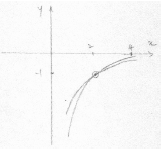| Date | May 2016 | Marks available | 2 | Reference code | 16M.2.sl.TZ2.9 |
| Level | SL only | Paper | 2 | Time zone | TZ2 |
| Command term | Write down | Question number | 9 | Adapted from | N/A |
Question
Let \(f(x) = \frac{1}{{x - 1}} + 2\), for \(x > 1\).
Let \(g(x) = a{e^{ - x}} + b\), for \(x \geqslant 1\). The graphs of \(f\) and \(g\) have the same horizontal asymptote.
Write down the equation of the horizontal asymptote of the graph of \(f\).
Find \(f'(x)\).
Write down the value of \(b\).
Given that \(g'(1) = - e\), find the value of \(a\).
There is a value of \(x\), for \(1 < x < 4\), for which the graphs of \(f\) and \(g\) have the same gradient. Find this gradient.
Markscheme
\(y = 2\) (correct equation only) A2 N2
[2 marks]
valid approach (M1)
eg\(\,\,\,\,\,\)\({(x - 1)^{ - 1}} + 2,{\text{ }}f'(x) = \frac{{0(x - 1) - 1}}{{{{(x - 1)}^2}}}\)
\( - {(x - 1)^{ - 2}},{\text{ }}f'(x) = \frac{{ - 1}}{{{{(x - 1)}^2}}}\) A1 N2
[2 marks]
correct equation for the asymptote of \(g\)
eg\(\,\,\,\,\,\)\(y = b\) (A1)
\(b = 2\) A1 N2
[2 marks]
correct derivative of g (seen anywhere) (A2)
eg\(\,\,\,\,\,\)\(g'(x) = - a{{\text{e}}^{ - x}}\)
correct equation (A1)
eg\(\,\,\,\,\,\)\( - {\text{e}} = - a{{\text{e}}^{ - 1}}\)
7.38905
\(a = {{\text{e}}^2}{\text{ }}({\text{exact}}),{\text{ }}7.39\) A1 N2
[4 marks]
attempt to equate their derivatives (M1)
eg\(\,\,\,\,\,\)\(f'(x) = g'(x),{\text{ }}\frac{{ - 1}}{{{{(x - 1)}^2}}} = - a{{\text{e}}^{ - x}}\)
valid attempt to solve their equation (M1)
eg\(\,\,\,\,\,\)correct value outside the domain of \(f\) such as 0.522 or 4.51,

correct solution (may be seen in sketch) (A1)
eg\(\,\,\,\,\,\)\(x = 2,{\text{ }}(2,{\text{ }} - 1)\)
gradient is \( - 1\) A1 N3
[4 marks]
Examiners report
Part (a) was in general well answered. Many candidates lost the marks for writing 2 or \(y \ne 2\) instead of \(y = 2\).
In part (b) some candidates got confused and found \({f^{ - 1}}(x)\) instead of \(f'(x)\). When calculating the derivative, two types of approaches were seen. Most of the ones who rewrote the function as \(f(x) = {(x - 1)^{ - 1}} + 2\), applied the chain rule correctly. Those who tried to apply the quotient rule made various mistakes: incorrect derivative of a constant, incorrect multiplication by zero, wrong subtraction order in the numerator, omitted the negative sign in the answer.
In (c), most candidates were coherent and obtained the same value as the one written in part (a).
In part (d) many candidates did not manage to differentiate the function g correctly. Of those who could, the equation was generally well solved algebraically.
For part (e), not many candidates wrote a correct equation with their derivatives. There was mixed performance for this question, as those who knew they needed to use their GDC managed to obtain an answer, while many got tangled in unsuccessful attempts to solve the equation algebraically. Many candidates tried to solve quite complex equations ‘manually’ instead of trying to graph the expressions on their calculators and finding the value of \(x\) at the point of intersection. Of those students who tried to solve graphically only a small percentage actually sketched the two curves that they were considering. This sketch is particularly useful to examiners to see how the student is thinking, or what steps s/he is taking to solve the equations.
Only a few realized that the question asked for the gradient, which was represented by the \(y\)-coordinate of the point of intersection, rather than the \(x\)-coordinate.

